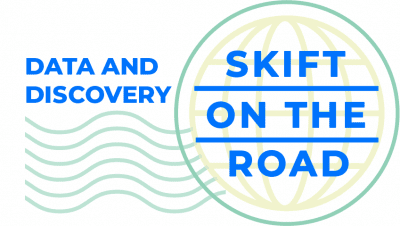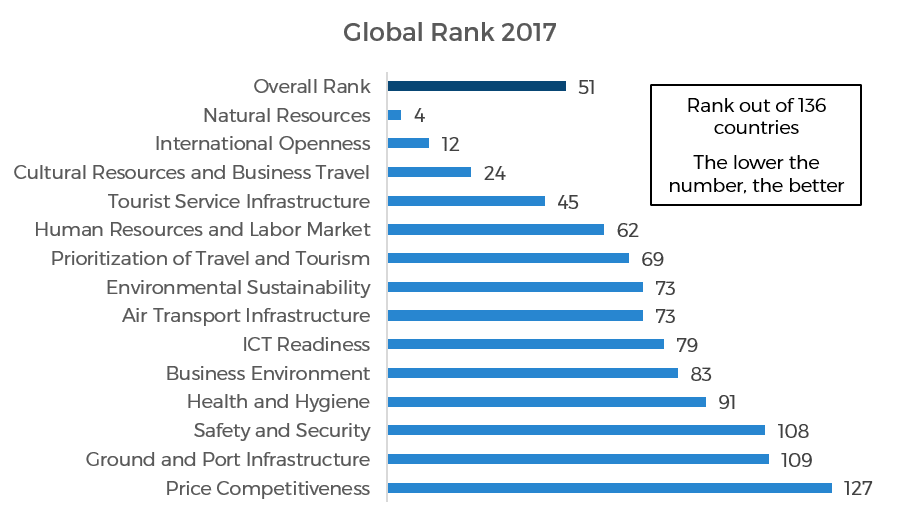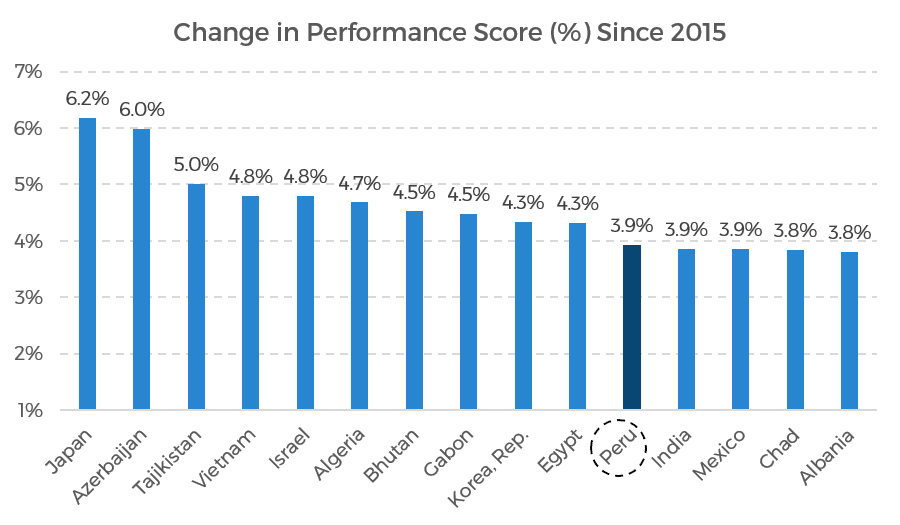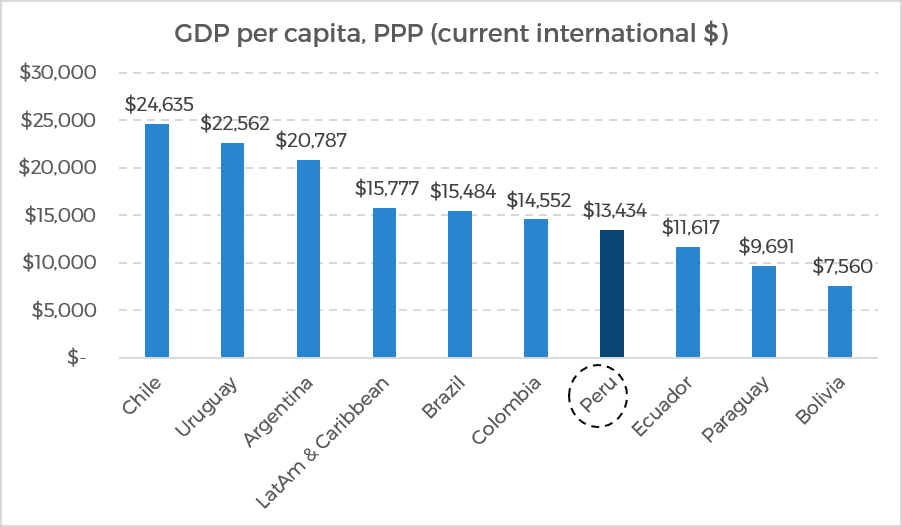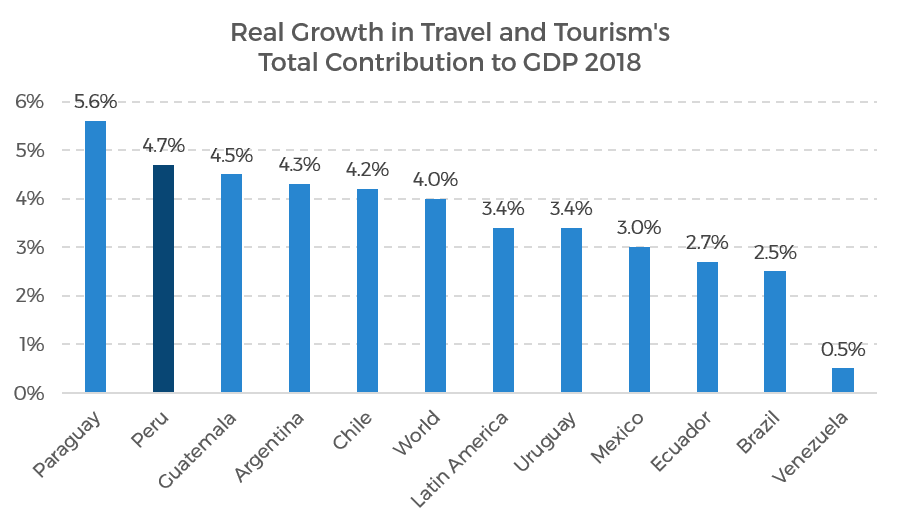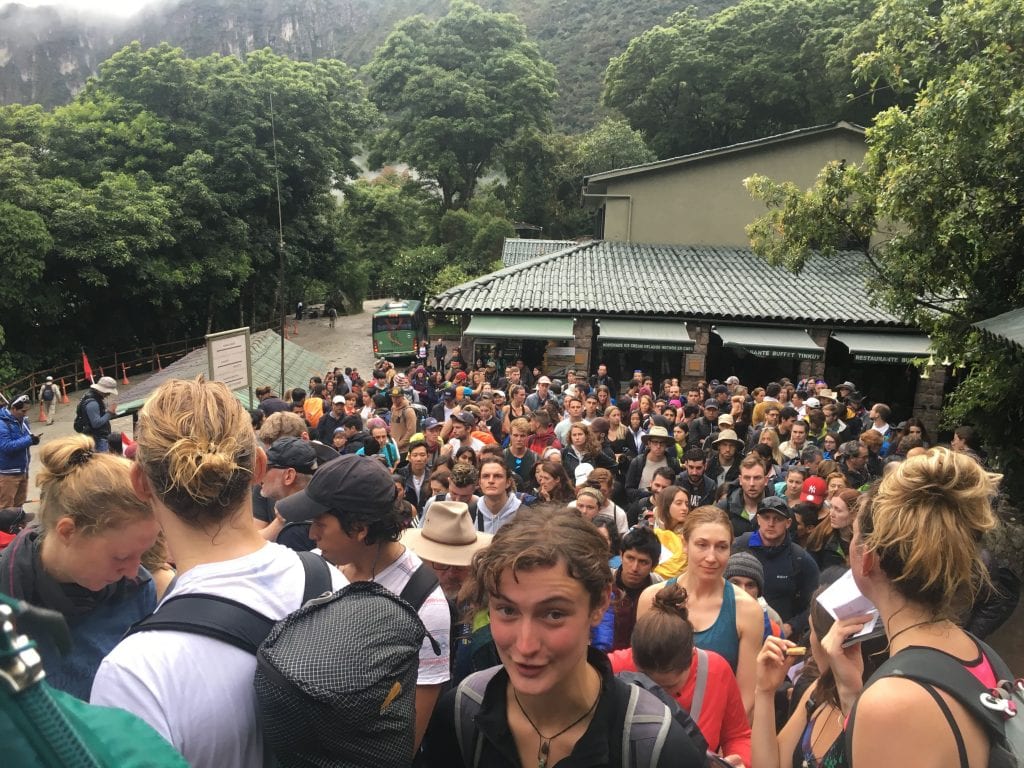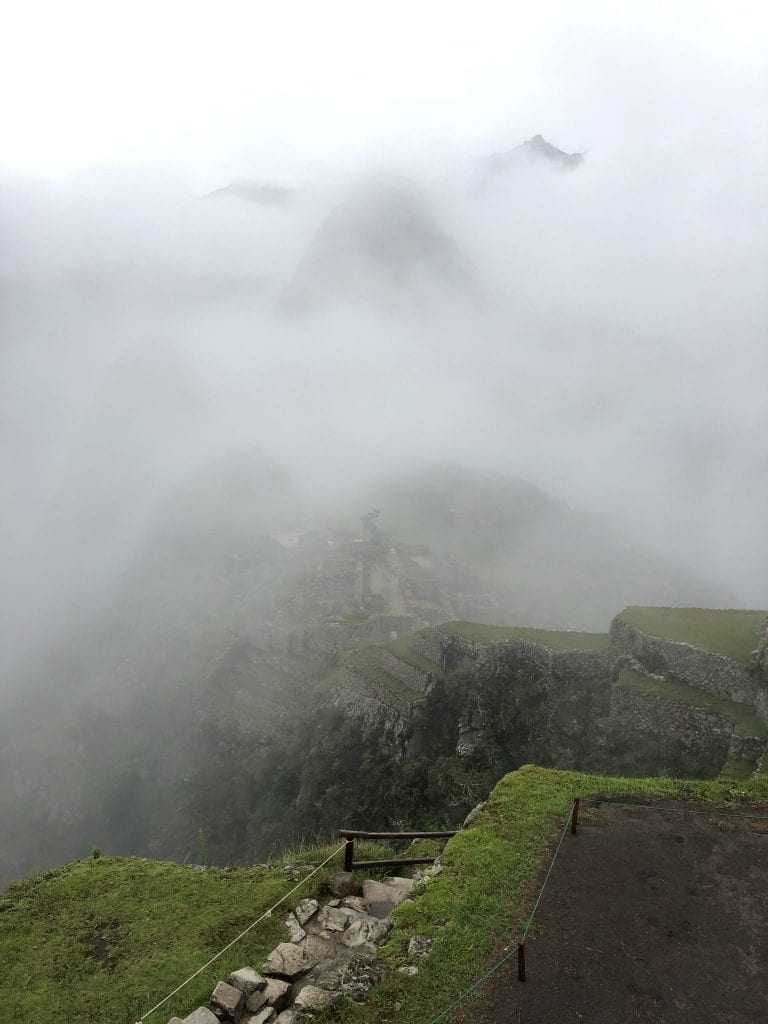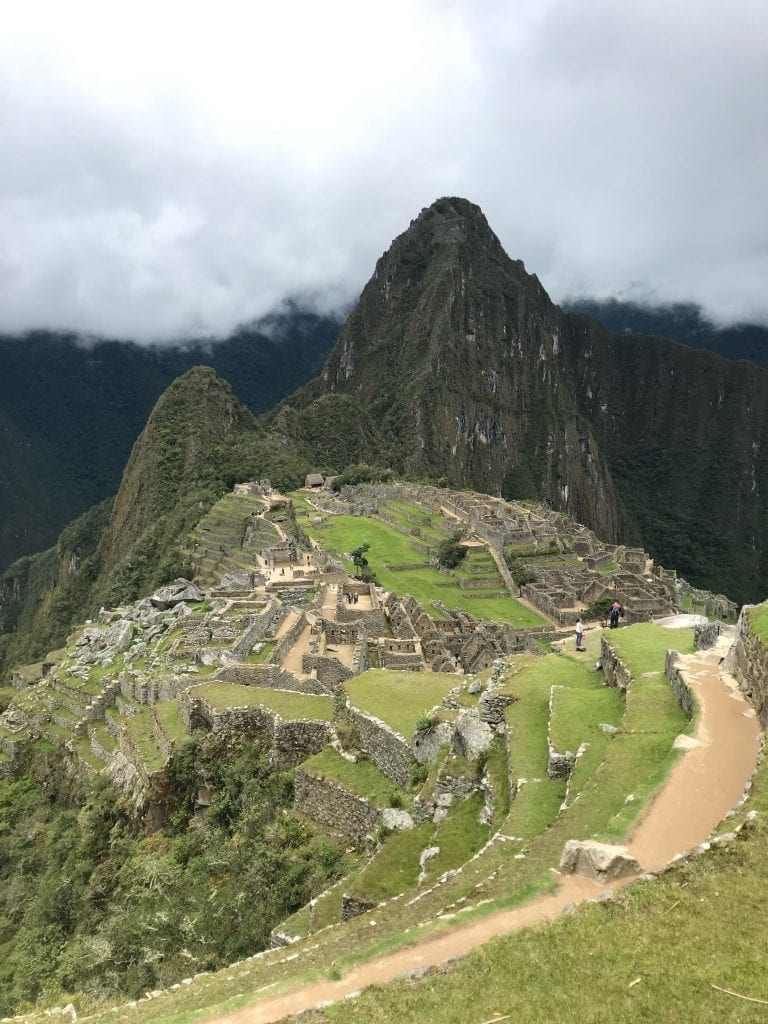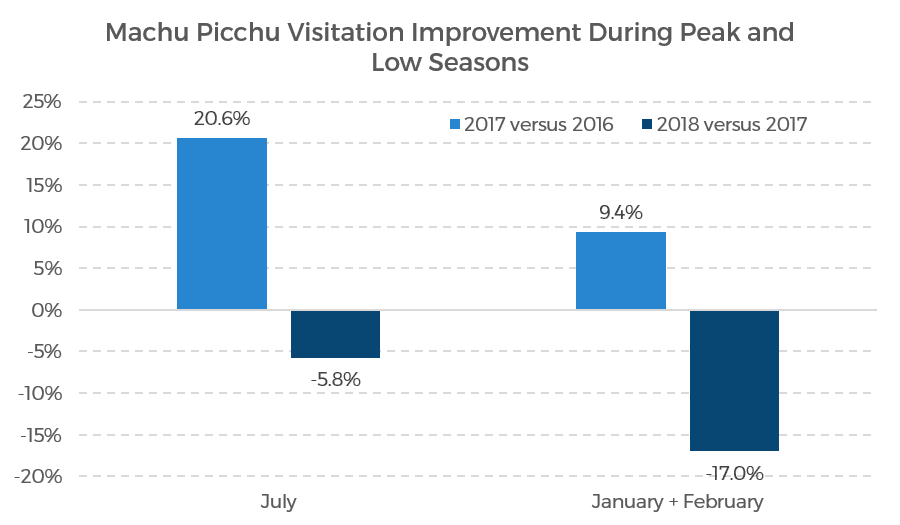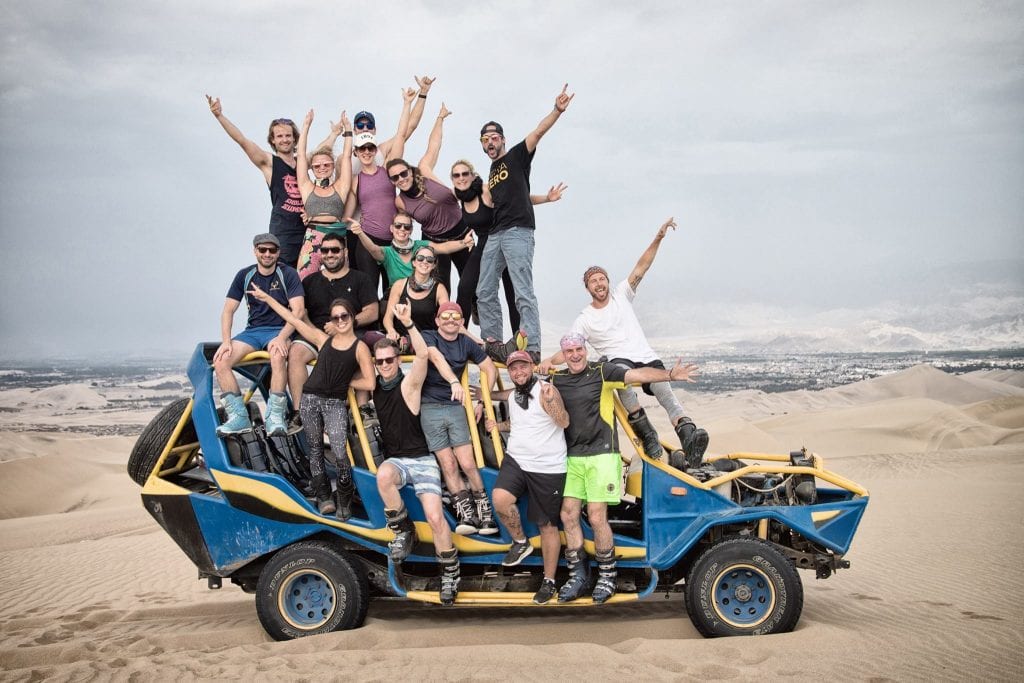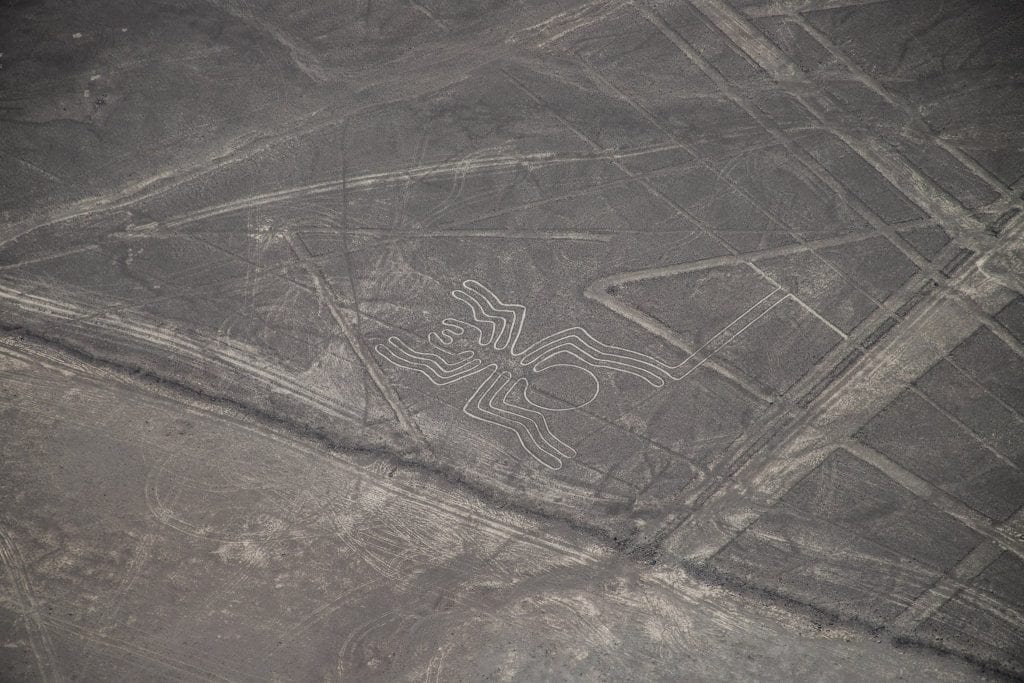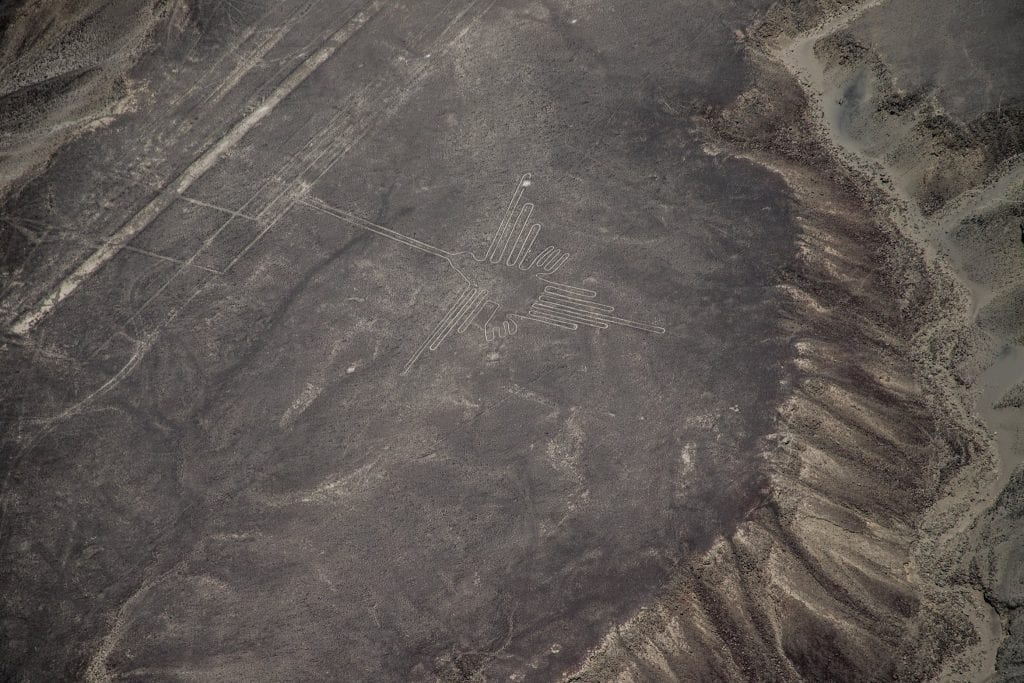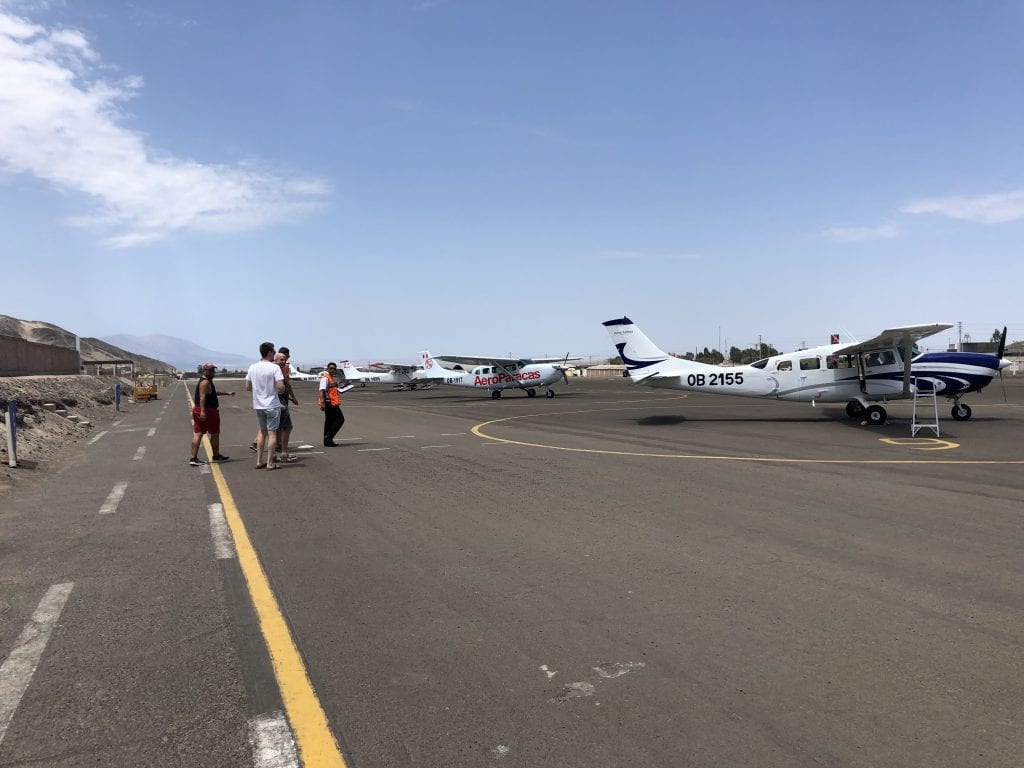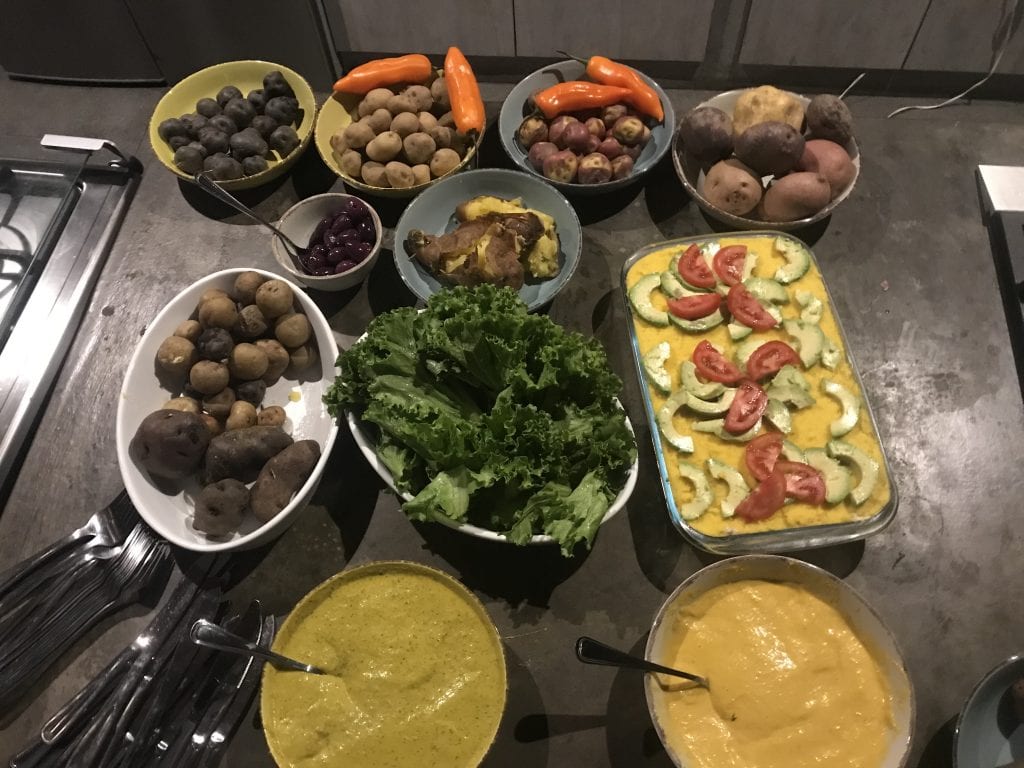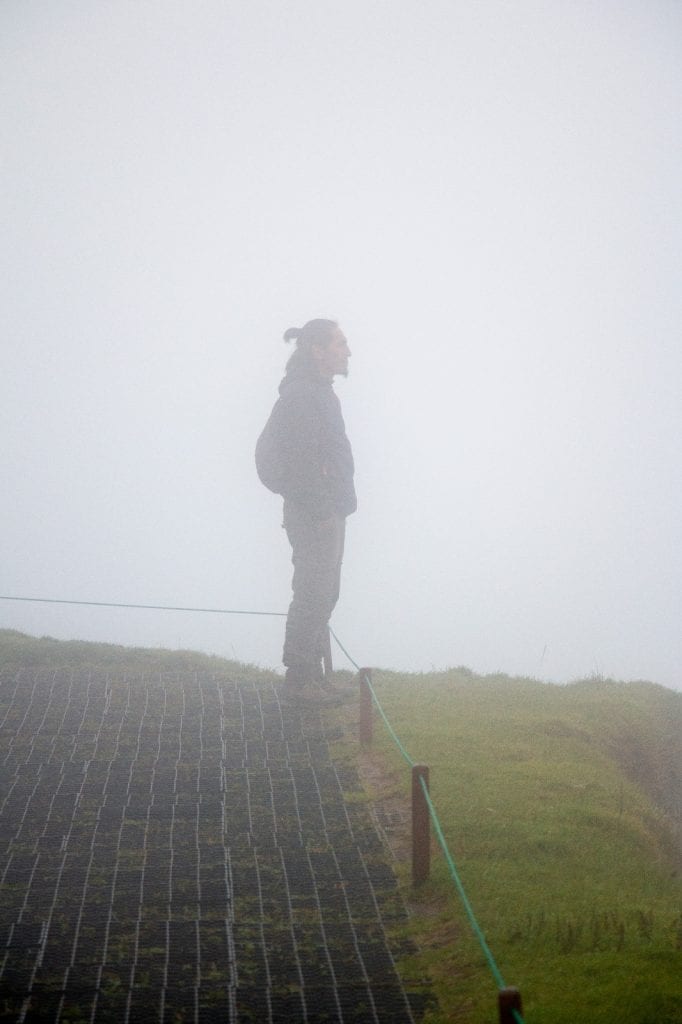Skift Take
Peru has done a lot in terms of diversifying its tourism industry, but a stronger emphasis on a unified vision for tourism is still needed. If governments don’t start prioritizing tourism — which has far-reaching impacts on other industries, the environment, and the lives of locals — we’re going to lose critical parts of history that help explain who we are and how we got here.
Skift Senior Research Analyst Rebecca Stone is traveling the globe over the next year as part of Remote Year, a program that brings together working professionals to travel, live, and work remotely. She'll spend a month in 12 cities around the world that include Cape Town, Lisbon, Valencia, Sofia, Hanoi, Chiang Mai, Kyoto, Kuala Lumpur, Lima, Medellin, Bogotà, and Mexico City. And every month she'll take you along for part of the journey with a feature about her observations based on firsthand reporting and data about the changing travel industry. She'll do the jet lag. All you have to do is kick back and enjoy her compelling dispatches.
When you think of Peru, you probably think of the same thing that I do — Machu Picchu.
I try to always “live like a local” when I travel, but this is one bucket list item I share with everyone. Four million people visited Peru in 2017; approximately one-third of those people (1.3 million) visited the 15th-century Inca citadel. That comes out to an average of about 3,600 people crawling all over Machu Picchu every day.
Machu Picchu continues to win awards for being the best tourist attraction in the world. A study by PromPeru, the tourism promotion agency of the Ministry of Foreign Trade and Tourism of Peru, confirmed Machu Picchu is the main reason people visit the country. But you probably could have guessed that.
Source: Adios Adventure Travel, “Top 100 City Destinations Ranking WTM London 2017 Edition” by Euromonitor International, Banco Central de Reserva del Perú, Peru Instituto Nacional de Estadística e Informática
The Peruvian government has been working to diversify its tourism industry, perhaps in response to UNESCO threatening to put Machu Picchu on the “List of World Heritage in Danger” and perhaps recognizing for the first time that its country has a lot to offer the world. Peru, in fact, has everything a traveler could be looking for — the Amazon rainforest, the Andes mountains, incredible archeological mysteries, deserts, beaches, delicious cuisine, and, of course, pisco sours.
“At the national level, I believe the Ministry of Tourism is working well to diversify the type of tourism we have in Peru. Through Marca Perú [an initiative to promote the purchase of products made in Peru] and other initiatives, Perú is starting to be recognized as a destination for not only Machu Picchu, but also nature and adventure, [and] food and sports tourism,” the Jhong Chung family, founder of Waranqu BnB, commented. “[But] despite the Ministry’s initiative to promote tourism and its diversification, these efforts and investments are not taken on by the regional and local governments.”
My Skift take after spending three weeks in Peru? The government has clearly taken steps to limit overcrowding at Machu Picchu and allowed for the development of a beautiful foodie scene in Lima. But the country has a long way to go in terms of developing better infrastructure, supporting other regions of the country where tourism is growing, and having a clear vision for the tourism industry moving forward. Nevertheless, I recognize other developing economies are facing similar issues. The prioritization of tourism does not seem to be at the forefront of many governments’ minds, and the resulting ramifications can have rippling effects throughout society, leaving no cultural identity, historical story, or precious archaeological landmark untouched.
Building Outside the Shadows of Machu Picchu
”The Travel & Tourism Competitiveness Report” is published biennially (most recently 2017) by the World Economic Forum and assesses economies (136 in 2017) against 14 pillars that measure how competitively and sustainably positioned a market is from a travel and tourism perspective.
Peru ranked 51st out of 136 economies, performing well on natural resources and international openness, and cultural resources and business travel, but poorly on safety and security, ground and port infrastructure, and price competitiveness.
Source: World Economic Forum, “The Travel & Tourism Competitiveness Report,” 2017 and 2015
Note: Pillars are also ranks out of 136 economies.
Interestingly, Peru was one of the most improved economies in 2017 versus the last time the report was published in 2015. The country had the 11th highest improvement in its performance score since 2015.
Source: World Economic Forum, “The Travel & Tourism Competitiveness Report,” 2017 and 2015
The country had the biggest improvement in percentage rank (Rank out of total number of economies) in environmental sustainability and natural resources. The country’s rank worsened the most in price competitiveness and, alarmingly, the prioritization of travel and tourism.
“The main issue that Peru faces is the seeming lack of infrastructure and poor management of public funds, or lack of transparency to explain how funds are spent and prioritized,” indicated Sarah Miginiac, general manager for G Adventures’ operations in Latin America.
Source: World Economic Forum, “The Travel & Tourism Competitiveness Report,” 2017 and 2015
Note: Calculation of Percentage Rank Improvement: Each pillar’s rank out of 136 in 2017 (and 141 in 2015) was calculated as a percentage (i.e. XX out of 136). 2015 was subtracted from 2017 to calculate how much the percentage improved in 2017. Each number was multiplied by -1 to make the chart more easily understandable as a decrease in 2017 would have meant an improvement in rank.
I’m going to cut the country some slack, however. Peru’s government has been dealing with corruption, bribery, terrorist organizations, hyperinflation, economic instability, and other issues for decades. Likely as a result of these issues, Peru has one of the lowest GDP per capitas in South America.
Source: World Bank
Note: “An international dollar would buy in the cited country a comparable amount of goods and services a U.S. dollar would buy in the United States. This term is often used in conjunction with Purchasing Power Parity (PPP) data.”
Note: Data for Venezuela not available.
On top of these economic challenges, the country has historically been reliant on mining, as Peru produces the most gold in Latin America and is second in production of copper, silver, and zinc globally. This conflicts with the mission of preserving archaeologically significant areas which happen to be, quite literally, all over Peru.
Nevertheless, the country is still aiming to double tourists by 2021 (to around 7 million). The World Travel and Tourism Council forecasted that Peru would have one of the highest real growth rates in travel and tourism’s total contribution to GDP in 2018.
Source: World Travel and Tourism Council
During my three weeks in Peru, I did my best to tackle as much of the country as I could with an open mind. And, as I did, I thought about how much progress has been made in terms of diversifying tourism and setting up additional infrastructure to better position the country for the future. Below, I present a brief account of three different experiences in three different Peruvian destinations: Machu Picchu, the Ica region, and the capital city of Peru, Lima. While I could see progress has definitely been made and certain initiatives have had a noticeable, positive impact, the country has a lot further to go.
Machu Picchu: A Well-Oiled Machine, But Not For Actually Getting There
I woke up at 3:30 a.m., and the first thing I thought of was my feet. I had been trekking on the Salkantay Trail for three days, and my feet were feeling it the most.
The Salkantay Trek to Machu Picchu is an alternative to the historically significant Inca Trail — the one the Incas built and took to get to Machu Picchu. My friends and I, hiking lovers and adventure enthusiasts at heart, chose the Salkantay, because it’s more difficult and arguably more breathtaking, but also because it’s significantly less crowded than the Inca Trail. I figured I could do my part to smooth issues of overtourism myself.
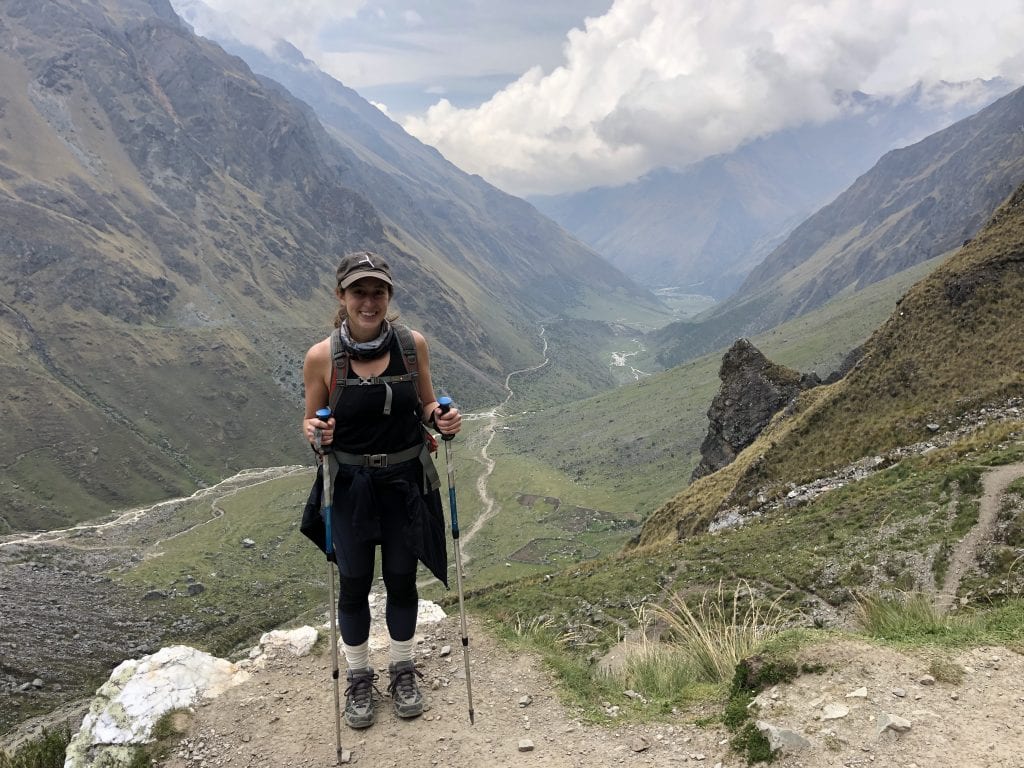
The Salkantay Trek is a less crowded route to Machu Picchu with gorgeous views; Photographer: Cameron McCallie
However, my thoughts of aching feet and exhaustion that morning quickly evaporated — I was finally going to get to see Machu Picchu that day. I quickly wrapped my toes and heels with tape before stuffing them back into my muddy hiking boots, grabbed my backpack filled with water, granola bars, and extra layers, and headed downstairs to meet my friends.
From there, my journey to Machu Picchu ran pretty much like clockwork. We left our hotel in Aguas Calientes (the town closest to the Inca citadel) at 4 a.m. and were some of the first people in line at around 4:25 a.m. While we waited in the dark for the gate to open at 5 a.m., the line of people behind us quietly grew and grew. At 5 a.m., we started our 3,000-step climb; after trekking for three days we were not about to take the bus up to the citadel like everyone else. At 5:45 a.m., we arrived at the top and high-fived each other as we waited in one more line — the gate to Machu Picchu — which opened at 6 a.m.
By 6:15 a.m., I was standing in awe of an abandoned civilization I had waited my whole life to see, only to watch it become completely engulfed in clouds a few minutes later.
By 9 a.m., I had toured the entire place, learning all about Inca society and some of the mysteries for which we will never have clear answers. The clouds had kindly blown over as well.
Around 9:15 a.m., my friends and I followed the path back out to the main gate to pay two soles (around $0.60 USD) to use the only bathroom available at the top.
We re-entered immediately to get in line for our last mountain to climb — Huayna Picchu — which offers some of the best views you can get of Machu Picchu.
At 10:00 AM (our entry time for Huayna Picchu), we signed a book registering our names and then hustled up the mountain. We took some pictures, climbed back down, signed back out in the book, and rode one of the buses back to Aguas Calientes.
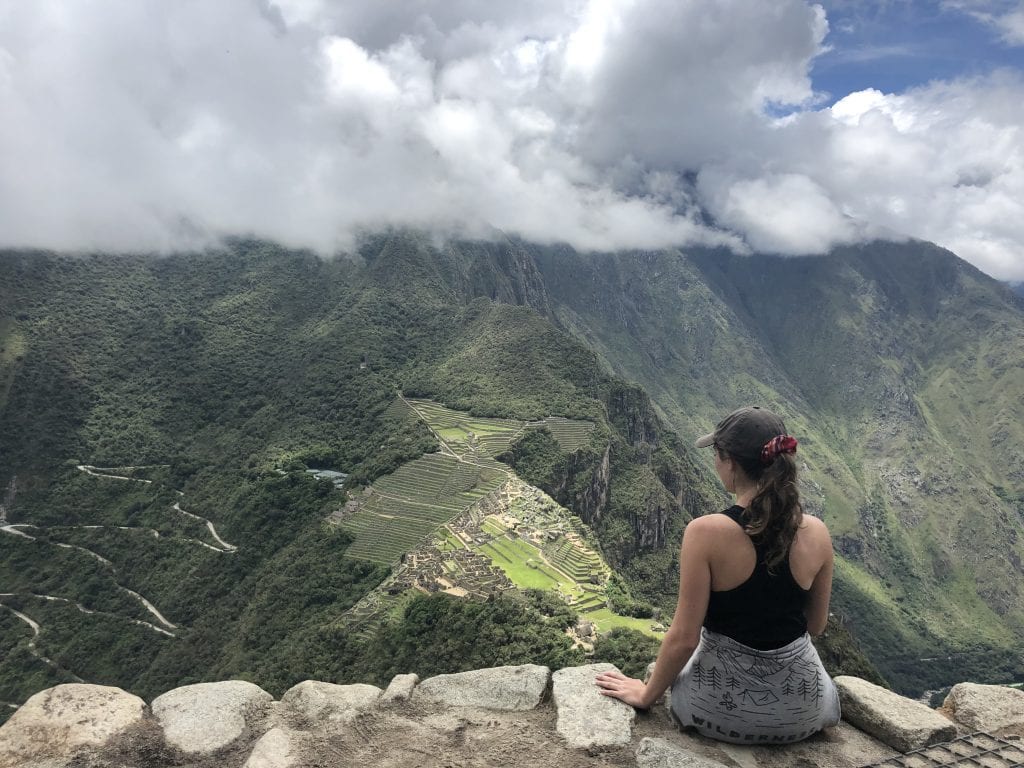
Th view of Machu Picchu from Huayna Picchu; The single bus route to the destination is visible on the left; Photographer: Stephanie Jones
My friends and I were toasting to our incredible experience trekking to Machu Picchu by noon. We laughed about the llamas we saw and how many coca leaves we chewed on, gaped at how little we could breathe at the top of Salkantay Mountain due to how high we were (We reached a max altitude of 4,650 meters that day), and discussed how Machu Picchu was way bigger and more magnificent than we thought it was going to be. And, as we talked about this being a trip we would never forget, I couldn’t help but think to myself, “I don’t think I’ve ever done that much before noon in my entire life.”
The Peruvian government has recently implemented a number of rules to help control congestion at the top of Machu Picchu — one of which includes separating tourists into two groups for entry: 6 a.m. to noon and noon to 5:30 p.m. As you can see from the account above, the rules have resulted in what I would consider to be a completely seamless experience. The entire morning ran like a well-oiled machine.
Interestingly, the new rules have received some criticism, because their implementation actually increased the number of permits for people to visit Machu Picchu – from 2,500 people per day to over 6,500. However, despite the greater availability of tickets, data suggests the new rules have, indeed, helped tourist inflows to the citadel. In July 2018, a peak month, visitation was down 5.8 percent versus being up 20 percent the year before. Adding January and February together (low season), 2018 visitation was down 17 percent versus being up 9 percent the year before.
Source: Adios Adventure Travel
Perhaps the new rules discouraged people from coming. Or perhaps the lack of enough infrastructure and the difficulty of navigating the logistics of getting to Machu Picchu are actually encouraging people to simply take their vacations to other globally competitive, but easier to get to, destinations they’ve seen on social media. Let me explain what I mean.
Peru currently only has one international airport, the Jorge Chavez International Airport, which only has one terminal for both international and domestic departures. To get to Machu Picchu, one must take a flight, likely after an international flight to Lima, to Cusco and, then, adjust to the altitude in a gorgeous city that has very weak Wi-Fi (I’m a digital nomad, after all, so these things can be pretty important) as well as weak toilets (our Airbnb’s water tank ran out twice during our stay) for the 3.5 million people who visit it annually.
But the journey doesn’t stop there. One must next take the single one-way train track to Aguas Calientes (or take a bus) from Cusco, and after that, if not trekking via the Inca Trail, take the single bus route to Machu Picchu. It’s this very complicated journey that makes me scratch my head and wonder, “Are you just trying to make it difficult to visit you, Peru? Do you want people to learn more about you and spend money in your economy?”
My frustration only increased when I found out about Choquequirao, another lost Inca city that happens to be 40 miles from Machu Picchu and three times as large. The site only receives a couple dozen visitors a day at most due to the fact that it’s completely inaccessible unless you’re willing to hike five days across a river and canyon to a citadel that’s 2,000 feet higher in elevation than Machu Picchu. I note the government has, indeed, approved a plan for a cable car to the top, but nothing seems to be moving so far.
“The government [should] facilitate new infrastructure in order to … [improve] access to other sites such as Kuelap [A settlement built by the Chachapoyas in the northern part of Peru] and Choquequirao to create a diversification of tourism attractions and spread the benefits of their economic impacts to more Peruvian communities” Sarah Miginiac of G Adventures stated.
A Weekend in the Ica Region: The Peruvian Smorgasbord of Tourist Attractions
We headed to the Ica region for a weekend of fun and a change of scenery from Lima. The Ica region is known primarily for the cities of Pisco (home to the vineyards used to create the grape brandy), Huacachina, and Nazca.
The city of Ica itself left a lot to be desired, but we settled nicely into our rooms at Waranqu BnB, as our lovely hosts, Luis and Victoria Jhong Chung, made us feel at home. They handed us pisco sours almost immediately and told us to hang out by the pool while they cooked us a delicious lunch. We relaxed in the morning before heading out to another oasis – Huacachina
Huacachina is a tiny village west of Ica that is as iconic as it gets when you think of the phrase “desert oasis.” But before we had a second to notice what an interesting geological area the village was, we were whisked away to ride dune buggies and go sandboarding.
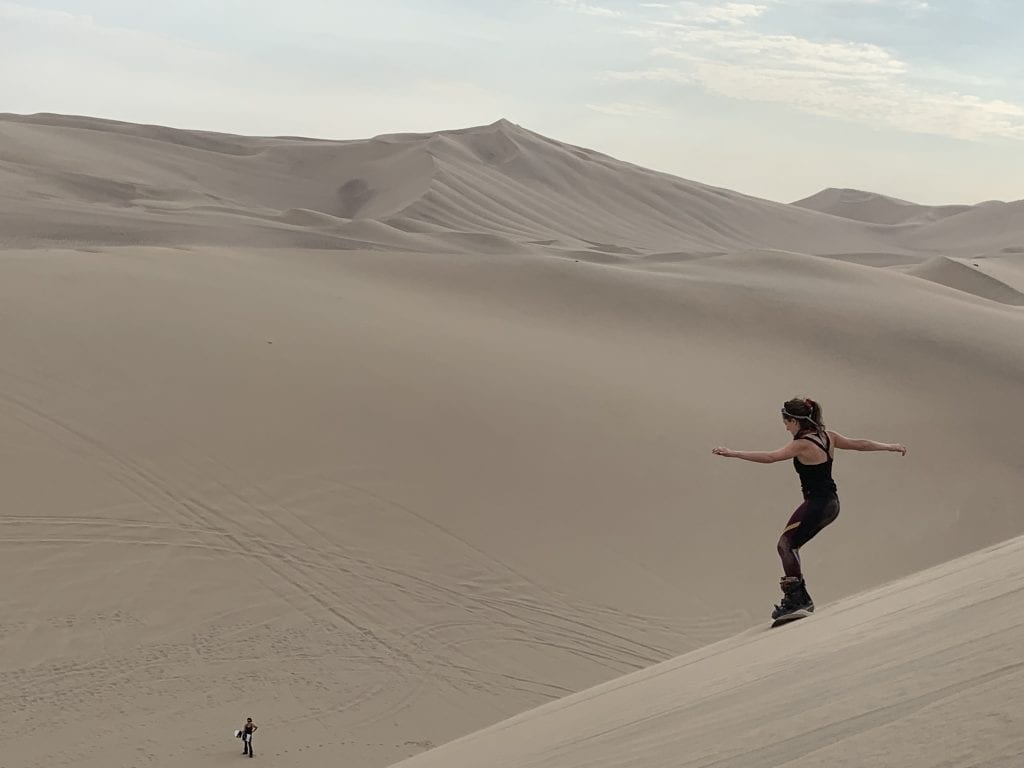
Sandboarding in Huacachina was entertaining, though not nearly as enjoyable as actual snowboarding (Turns out, sand makes you stick); Photographer: Will Dunn
Though fun from an entertainment perspective, I learned nothing about how the Huacachina oasis was formed or the history of the desert. I later found out that, as recently as the fall, the dune buggies had been temporarily banned because a tourist had died while riding in one in August 2018. However, they all apparently began operating soon after. Turns out, all of the operators are unregulated by the authorities, because “hay un vacío en la ley que las ampara.” (Essentially: There is a gap in the law that covers them). Comforting.
The next day, a few of us went to Nazca to view the Nazca lines, which are considered by some to be one of the world’s greatest mysteries. The Nazca lines feature approximately 800 straight lines (some up to 30 miles in length), 300 geometric shapes, and 70 animal and plant figures which range 50 to 1,200 feet in length.
The lines are believed to have been made by the Nazca people who lived in the area around 500 B.C. to 500 A.D, long before the Incas, whose empire was at its height during the 1400s to mid-1500s. The reason for creating the lines remains a mystery, but, one thing’s for certain, they’re best viewed from above. The lines weren’t even really brought to attention until the rise of air travel in the 1930s.
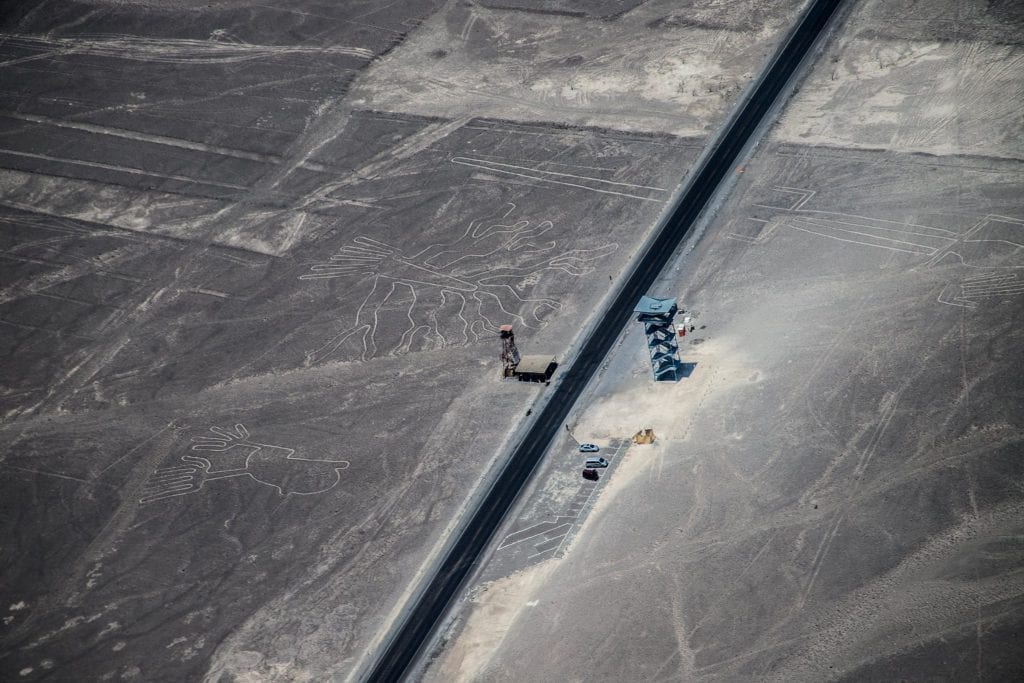
The hands, tree, and lizard; Note how the highway was built directly through the lizard; Photographer: David April
After visiting a tiny museum dedicated to Maria Reiche, a German who studied the lines for 40 years and fought for their protection and preservation, we headed to the airport. The irony of the fact that she was German and not Peruvian wasn’t lost on me as I climbed into the back of the tiny plane that would chauffeur us around the sky for a tour of the lines.
Thirty minutes later, I was completely nauseous, but safely on the ground, and we headed to the Chauchilla Cemetery where we would view the remains of at least 20 mummified Nazca people. The graves were only protected by the Peruvian government starting in 1997, but the damage had already been done — essentially all of the graves had been ravaged by grave robbers over time.
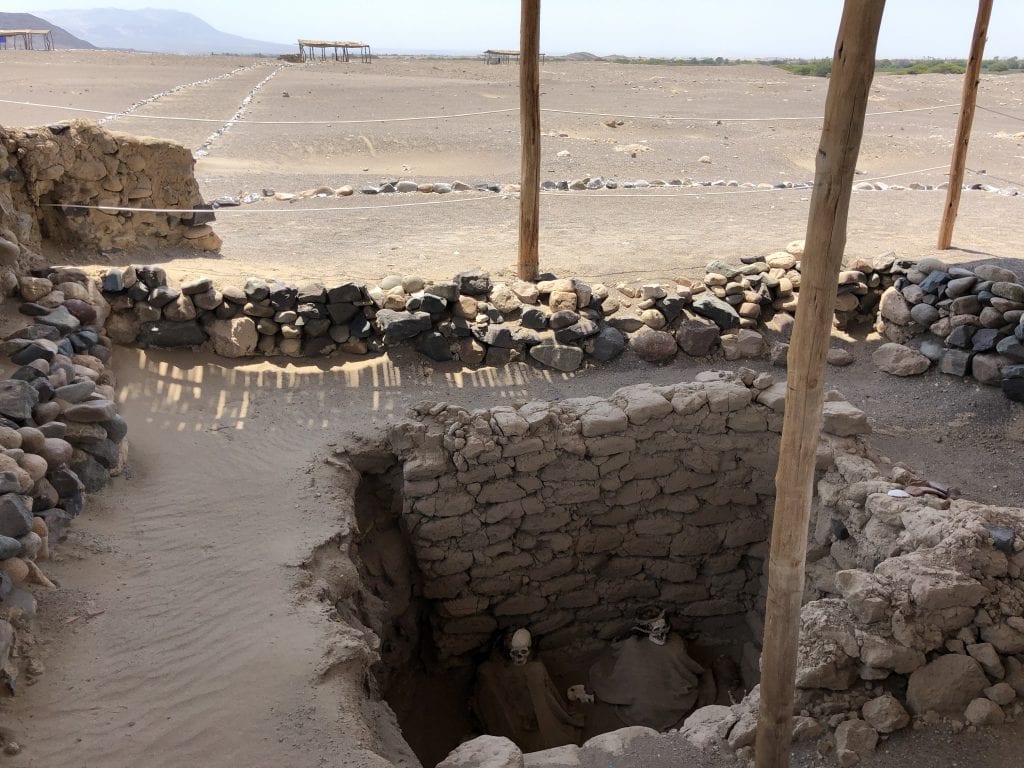
The graves at Chauchilla Cemetery, open, exposed, and available to the public, have been ravaged by grave robbers over the years.
We stared in awe into the open graves at how in-tact the remains were — many had a full head of hair. I asked our guide, “Are they okay to be out in the open and exposed like this? I know the climate in the desert is dry, but what about wind or rain or anything?”
The guide shrugged and laughed. “I suppose when these get damaged, they’ll [the government] just open up some more graves to the public.”
Tourism for Nazca cannot be described as a well-oiled machine. Fifty new lines dating hundreds of years before the currently famous Nazca lines were discovered in early 2018 using drones.
“The [new] Nazca lines, in the desert around Palpa and Ocucaje, were discovered by locals, but there has not been any sign of interest from local governments or media to start any exploration on these sites,” indicated the Jhong Chung family, founder of Waranqu BnB.
What’s more, a man was even able to drive a truck over some lines in January 2018, critically damaging them, showing just how “protected” these lines really are.
“The boom of tourism [in Peru] has also reached Ica, which is now receiving a large amount of tourists every year. This has generated more jobs for locals, resulting in an improvement of the livelihoods of people,” the Jhong Chung family of Waranqu BnB noted. “However, there is a minimal involvement of the government in helping develop tourism, monitoring and regulating the sector, and promoting local and sustainable tourism.”
On the six-hour drive back to Lima, I felt more confused by my weekend in the Ica region than feeling like I had a better understanding of its cultural identity and history.
Lima Celebrates and Showcases Peruvian Culture Via Cuisine
I wouldn’t describe Lima as “the belle of the ball” when it comes to cities (though its beach sunsets might give Cape Town a run for its money on some days). The city ranks highest for the worst air pollution out of major cities in North and South America (talk about grey skies), and the unbearable traffic and congestion on its highways kept me awake most nights (my apartment was right on Via Expresa Paseo de la República).
“Lima’s capacity to accommodate its own inhabitants and provide them with basic public service is in danger. … Moreover, Lima needs an urgent improvement of public transportation as it is currently almost non existent,” the Jhong Chung family of Waranqu BnB stated.
But if there is something that Lima gets absolutely right, it’s food. Lima has three restaurants on the list of the World’s 50 Best Restaurants (Two, Central and Maido, are in the top ten). In fact, Peru has ranked as the World’s Leading Culinary Destination for the past seven years. A study by PromPeru in 2017 found that 82% of visitors consider Peru a gastronomic destination.
Eating in Lima isn’t just about eating good food – it’s about learning about Peru’s different cultural identities, getting to taste a piece of history, and better understanding the love and hard work that Peruvians put into everything they do.
I ate the best lomo saltado (a stir fry dish of sirloin strips, onions, tomatoes, and french fries that speaks to Peru’s Chifa cuisine — Peruvian ingredients influenced by Cantonese elements as a result of the Chinese migrating to Peru during the 19th and 20th centuries) at Isolina in Lima’s Barranco district. I enjoyed delicious Peruvian ceviche (traditionally comes with fish, potato, corn, and red onion) and drank chicha morada (a national beverage originating from the Andean regions consisting of purple corn, cinnamon, and cloves) essentially everywhere that I could.
I learned how one of the most globally consumed foods in the world — the potato — actually originated in the southeastern part of Peru (and northwestern Bolivia), and the country has around 3,800 types. I experienced first-hand how important the potato is in Peruvian cuisine by making causa (a cold mashed potato casserole with tuna or chicken) in a cooking class all about potatoes with Chef Germán Roz.
I realized just how special Peruvian cuisine is at Central Restaurante, located in the Barranco district. Created by superstar chef, Virgilio Martínez Véliz, who was featured in an episode of Chef’s Table on Netflix, Central offers a one-of-a-kind experience that includes ingredients from all over Peru. Over 16 courses, one experiences flavors from all different altitudes covering every corner of the country.

This was a chocolate dessert dish called “Mountain Rain” from the altitude of 2,100 meters; Photographer: David April
Lima, which was once a grey pitstop on the way to lovely Cusco (and Machu Picchu), has been transformed by the development of its food scene. Peru’s gastronomic association, Apega, estimated the country’s food tourism industry at around $7.5 billion as of 2016.
“I think our cuisine was underestimated because we, Peruvians, took it for granted,” the Jhong Chung family of Waranqu BnB commented. “The realization of our culinary richness came when we started opening our doors to the world, and tourists started to taste Peruvian cuisine.”
A survey conducted a couple years ago indicated that 39 percent of Peruvians view gastronomy as a main source of national pride, ahead of Machu Picchu at 36 percent.
And they should be proud. Every bite I took, I felt like I got a better sense of who Peru is.
Prioritize Tourism: Losing Your History is at Stake
I hope from the three destinations you can see that, while Peru has been working towards better showcasing its identity and mitigating issues of overtourism at attractions like Machu Picchu, there is certainly a lot more work to be done.
“Given Peru’s unstable economic and political past, for many years there was no prioritization from the government in discovering/preserving pre-Inca and Inca sites, which resulted in the destruction or damage of many sites, textiles, ceramics, etc. Although the government is starting to invest more in tourism, there is still a lack of appreciation in many of our ancient ruins, especially in those sites that are new or not very well developed … We see how mining companies establish mining camps under archeological sites destroying fossils, ruins, etc. I think the value of our history and nature should be better understood by our higher authorities,” the Jhong Chung family of Waranqu BnB stated.
“They had promised to double up tourism within five years. But in truth, the development of essential tourism infrastructure such as airports is vital if we want more travelers to arrive. The other important need is the formalization of tourism. There are still too many unofficial, unregulated, unprotected services being offered to tourists, which create some risk and insecurity for the travelers and, in some cases, have led to accidents or misunderstandings,” Sarah Miginiac of G Adventures said.
If governments and local authorities don’t start prioritizing tourism — which has far-reaching impacts on other industries, the environment, and the lives of locals — we’re going to lose critical parts of history that help explain who we are and how we got here. We’re losing history.
Why did the Nazca people draw those lines, and how have the lines managed to last 2,000 years without being seriously damaged? How exactly did the Incas simply abandon their citadel at Machu Picchu — allowing the forest to perfectly cover, protect, and preserve it until it was “rediscovered” in 1911? Why won’t Peru implement more initiatives to better support the preservation of its history and make it easier for travelers to better understand who Peru is?
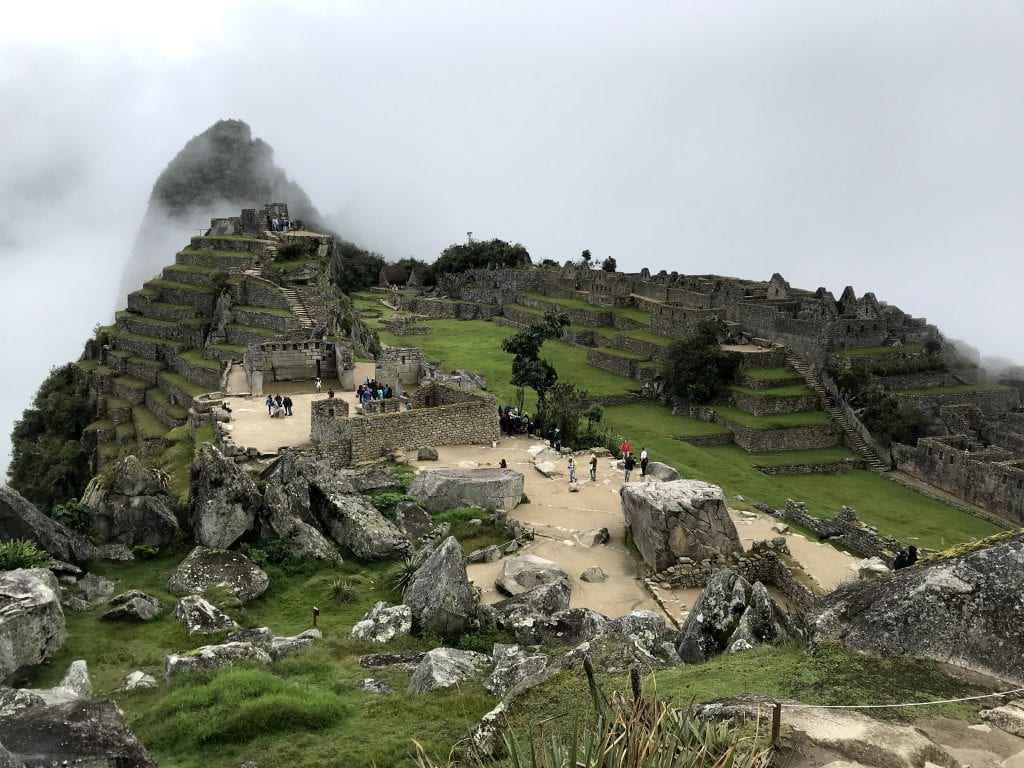
Some things we will never know or fully understand, but we have the opportunity to learn and to implement initiatives that help preserve history for future generations; Photographer: Annika Wikberg
I can’t help but wonder what would have happened if the Spanish had never invaded Central and South America destroying so much either physically or via the spread of disease, leaving us with only questions and mysteries to solve about the sophisticated, highly advanced, civilizations that once lived there.
But here we are today, and now it’s up to us to preserve and showcase what we still have before it’s too late.
The Daily Newsletter
Our daily coverage of the global travel industry. Written by editors and analysts from across Skift’s brands.
Have a confidential tip for Skift? Get in touch
Tags: climate change, data and discovery, destinations, lima, machu picchu, peru, skift on the road, skift research, sustainability, tourism
Photo credit: Newly implemented rules at Machu Picchu help the destination run like a well-oiled machine, but the country has more work to do; Photographer: Cameron McCallie Cameron McCallie

